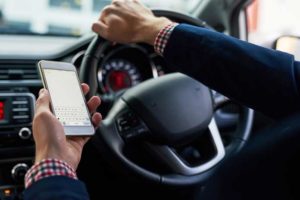Minnesota has become the latest state to crack down on distracted driving by banning handheld cell phones behind the wheel. The new law goes into effect August 1, 2019, making Minnesota the 16th state to adopt a “Hands Free” mandate for drivers.
Car crash attorney Fred Pritzker hailed the legislation as a positive step. “We all understand the danger of distracted driving but knowing about it hasn’t changed the behavior,’’ Pritzker said. “We need more actions like this to wipe it out.’’
Dialing, talking, texting and emailing on cell phones is part of a distracted driving epidemic that has led to more than 420,000 injuries and more than 3,100 deaths every year in the United States. If you or a loved one have been victimized by this negligence, exercise your legal right to an attorney. Contact the Pritzker Hageman law firm to learn more.
Hold Distracted Drivers Accountable

April is Distracted Driving Awareness Month. Senseless accidents in this category are owed to distractions of all types, but cell phones and tablets are at the center of it. Nearly one-third of all U.S. drivers 18 to 64 years old read or send text or email messages while driving. Others have been known to scan social media while driving. Teen-aged girls are the most frequent offenders, but drivers across the board scoff at common sense by handling cell phones while driving, causing automobile deaths and injuries.
Some people believe they can multi-task and drive safely. But a car traveling at 55 miles per hour covers more than 80 feet every second. If a driver takes just 4.6 seconds to send or read a text, he or she will travel the length of a football field without visual guidance.
Furthermore, studies have shown the overall crash risk increases 3.6 times when a driver interacts with a handheld device. Studies also have shown that a driver can fail to notice something fully visible when focused on a secondary task like talking on a cellphone. They miss visual cues they would otherwise pick up.
#JUSTDRIVE
More states are establishing criminal consequences for distracted driving and the legal system has developed tools to aid prosecutors and strengthen evidence for distracted driving lawsuits. Our own distracted driving cases aim to hold irresponsible drivers and their insurance companies fully accountable for wrongful deaths and injuries that disrupt and diminish the lives of our clients.
The distracted driver that rear-ended your car or “T-boned” your vehicle robbed you of the safety you deserve as a conscientious driver. But it’s up to your lawyer to prove that the driver’s attention was averted from the roadway, causing the crash. The judge or jury will need proof that the actions of the at-fault driver were unreasonable.
A good distracted driving lawsuit will investigate what information is available from cell towers, cell phone providers and from the phone itself. Were there witnesses to the crash? Can they shed light on the driver’s behavior? Was the vehicle driven by the distracted driver equipped with an event data recorder, or black box? Could that explain the action—or lack of action—taken in the moments before the crash?
Investigators sometimes can gather evidence from the people “on the other end of the phone’’ at the time of the crash. Could they attest to the choices the distracted driver was making when the crash occurred? Our attorneys solidify the foundation of your distracted driving lawsuit.
Distraction as a Crash Factor
Still, it’s not always possible to determine distraction as a crash factor. That’s why transportation officials believe cases of distracted driving are under-reported. In Minnesota from 2013-2017, distracted or inattentive driving was found to be a contributing factor in one in five crashes, resulting in an average of 53 deaths and 216 serious injuries each year. But the Office of Traffic Safety estimates these numbers don’t reflect the full impact of distracted driving. Crash experts also stress that distracted driving is not just cellphones and texting. It can be anything that takes your attention away from driving: adjusting your radio, eating, reaching, doing makeup and dealing with kids or other passengers.